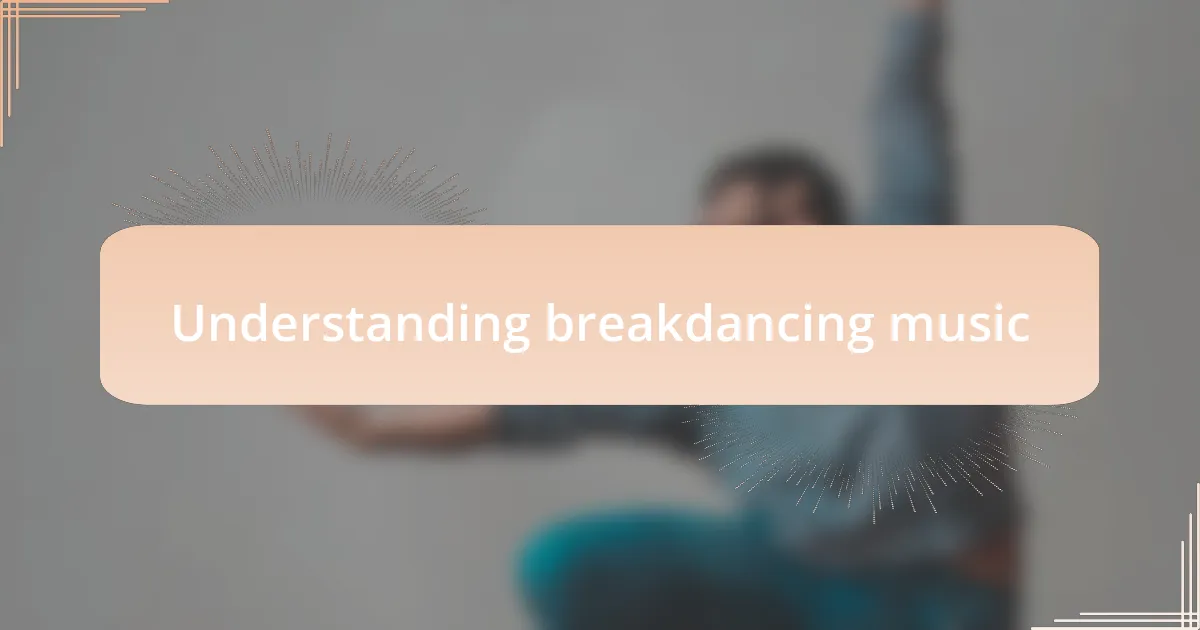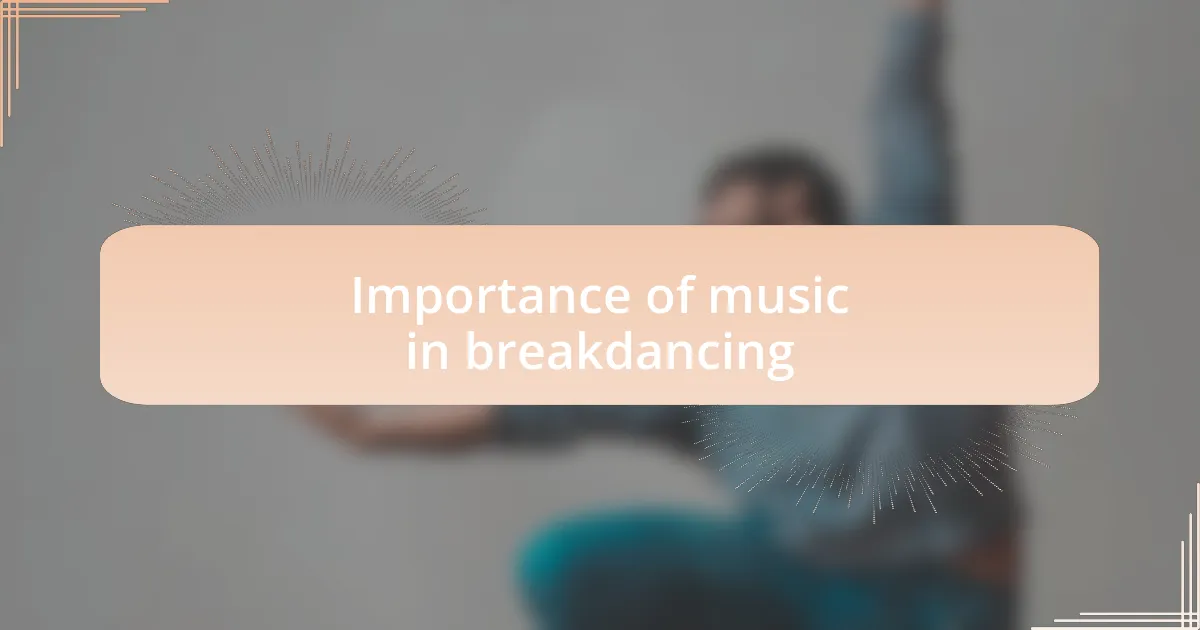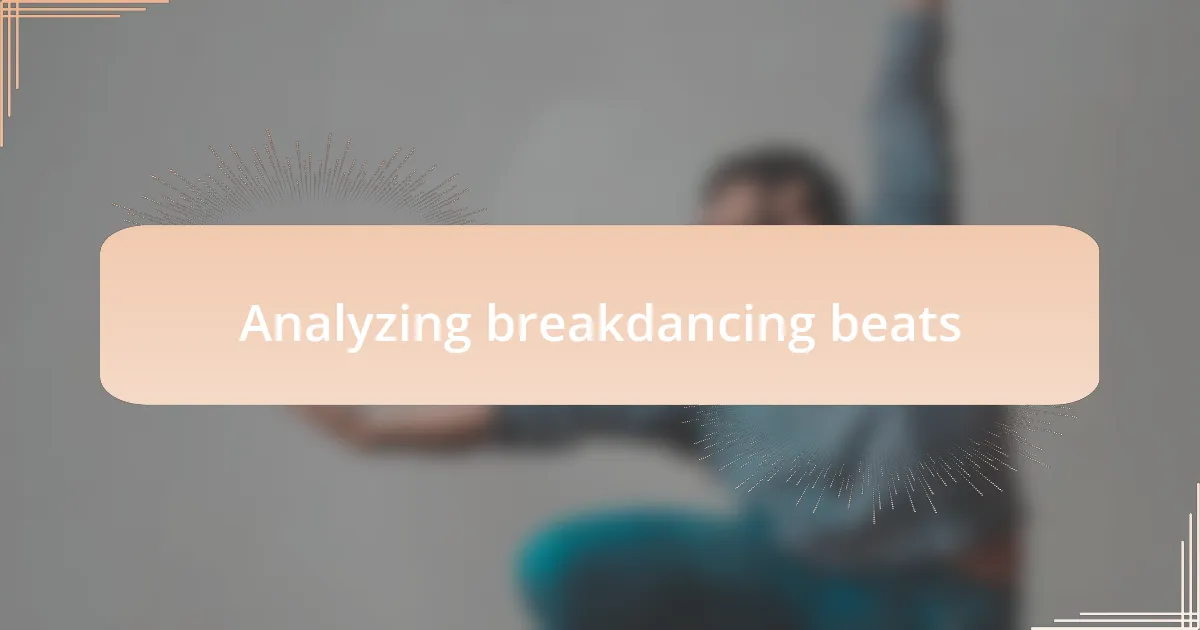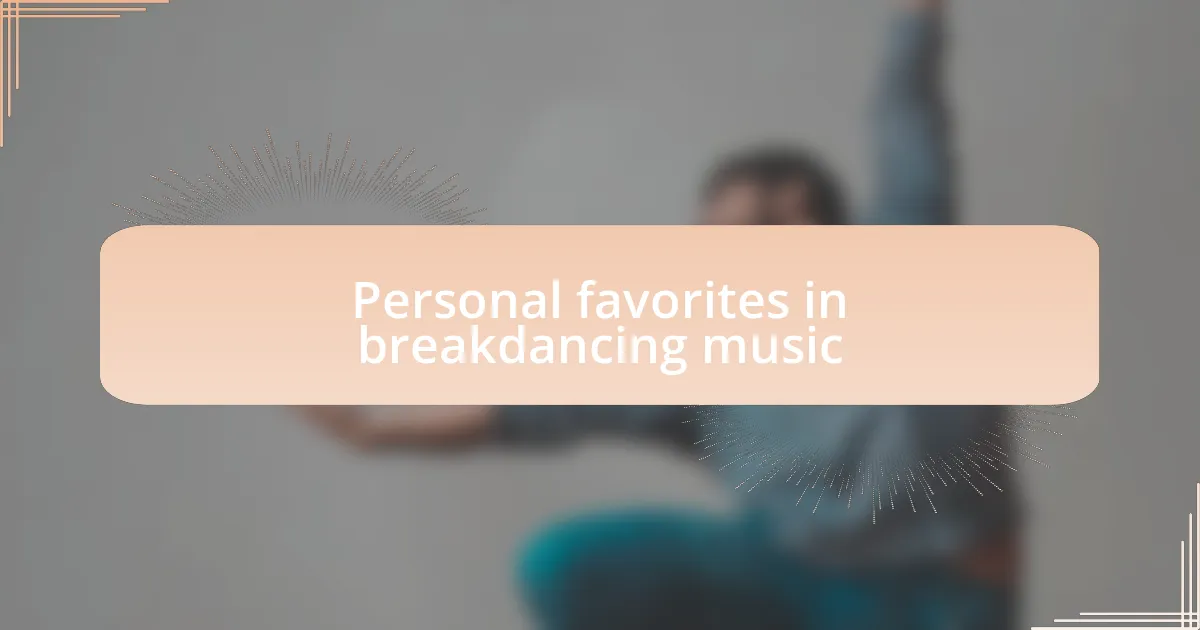Key takeaways:
- Breakdancing music is essential for influencing dancer energy and performance, drawing from hip-hop, funk, soul, and disco.
- The right music enhances emotional expression and personal storytelling during dance, making each session a unique experience.
- Genres such as hip-hop, funk, and electronic music provide a dynamic backdrop, while unconventional choices can spark creativity in choreography.
- Analyzing beats, tempo, and instrumentation can refine personal style and flow, significantly impacting practice routines.

Understanding breakdancing music
Breakdancing music is more than just a backdrop; it’s the very heartbeat of the dance. I vividly remember my first b-boy session, surrounded by artists moving to the rhythm of classic hip-hop. It struck me how the beats not only set the tempo but also influenced the energy in the room—there’s something electric about a song that resonates with the moves you’re making. Can you feel that rush when a perfect track drops?
Understanding the genre is crucial. Breakdancing draws deeply from hip-hop, funk, soul, and even disco, blending those elements to create an atmosphere ripe for expression. I’ve found that tracks with a strong, steady beat work wonders in elevating your performance. When I hear a funky bass line drop, it almost feels like an invitation to take my dancing to the next level. It makes me wonder, how does each track inspire your personal style on the dance floor?
It’s fascinating how choice of music can transform a session. When I’m practicing, I sometimes gravitate towards instrumental tracks. They offer a space for creativity, allowing me to focus solely on my movements without lyrics pulling my attention. Have you ever noticed how certain sounds can trigger memories and emotions that fuel your passion for dancing? The right song can turn a simple session into an unforgettable experience filled with joy and connection.

Importance of music in breakdancing
Music in breakdancing is not just a companion; it’s a critical partner in the dance. I still recall a moment at a jam, when the DJ spun an old-school track. The moment that first beat hit, the energy shifted. It was as if every dancer felt connected, charged with a collective vibe that can only be created through music. How can you ignore the pulse of a song when it flows through you, urging you to move in sync?
The right music can evoke intense emotions and inspire creativity. I often find myself choosing tracks that resonate with what I’m feeling that day. For instance, if I’m channeling some frustration, a heavy, aggressive beat can help express that pent-up energy through powerful spins and freezes. Have you ever found yourself lost in a track, only to emerge feeling invigorated and inspired? That connection can turn a simple practice session into a cathartic experience.
Melodies also provide a means of personal storytelling. When I dance to a song that holds a special memory, the movements become an extension of that narrative. I remember competing to a track that had been playing during my very first battle. The nostalgia flooded through me, and it felt like I was dancing through my journey. Doesn’t it make you see how personal music can shape each dancer’s expression and ultimately their identity?

Genres suitable for breakdancing
Finding the right genre to breakdance to is crucial, and I often gravitate toward hip-hop and funk. These genres offer a rawness and energy that match the dynamic nature of breaking. I remember the first time I hit the dance floor to a classic funk track; it was as if the music had ignited something within me, propelling my body into each move effortlessly. Can you relate to that feeling when the perfect song just clicks?
Another genre worth exploring is electronic music, especially tracks with heavy basslines and rhythmic drops. I sometimes find myself losing track of time while practicing to a thumping electronic beat. The way the drops coincide with powerful freezes and spins creates a synergy between music and movement that feels almost magical. Have you ever felt that pulse urging you to push beyond your limits?
Lastly, don’t overlook rock or even jazz-infused tracks. They provide a unique flavor that can inspire innovative choreography or add a flair to classic moves. A few months back, I tried breaking to a jazzy remixed rock song during a session, and it turned my routine on its head. The blend of unexpected rhythms challenged me to adapt and rethink my transitions. Isn’t it fascinating how stepping outside our usual genres can open up new avenues for expression?

Analyzing breakdancing beats
When I dive into analyzing breakdancing beats, I pay close attention to the tempo and rhythm structure. A track that swings between fast and slow can introduce an exciting dynamic into my routines. I recall a session where I experimented with an old-school hip-hop track that had a slower intro; it allowed me to showcase my controlled power moves before launching into faster footwork. How does a beat’s pace influence your personal flow?
Instrumentation is another layer I consider in my beat analysis. I often find myself drawn to tracks with striking brass sections or heavy percussive elements. Once, I was jamming to a beat with prominent conga drums, and the way each hit resonated felt like it was telling me when to pop or lock. Have you experienced that electrifying connection where a beat almost feels alive?
Finally, I think about how the interplay of sounds affects my creativity. For instance, I once mixed a dance practice with a track that incorporated nature sounds, like rain and thunder, beneath the beats. It was refreshing and inspired a unique set of expressiveness in my movements. Have you ever danced to a track that made you feel like you were telling a story, blending sound and motion seamlessly?

Selecting tracks for practice
When I select tracks for practice, I often gravitate toward those that have a consistent beat. For instance, I remember a session where I used a track with a steady 90 BPM. That uniformity allowed me to focus on perfecting my moves without getting lost in shifting rhythms. Have you ever found that the predictability of a beat helps you hone your skills better?
I also pay attention to the emotional vibe of the track. For example, I once practiced to a song that had a nostalgic feel, making me channel a deeper expression in my routines. The mood of the music really shapes not just my movements, but the entire energy of the practice. Do you think the emotional essence of a track enhances your performance as well?
Finally, I love experimenting with different genres. One day, I chose a track from an electronic music playlist, and to my surprise, it led to some innovative transitions in my dancing. The unexpected elements sparked a new flow that I hadn’t tapped into before. Have you explored other music styles that shuffled your routine into something fresh and exciting?

Personal favorites in breakdancing music
When I think about my personal favorites in breakdancing music, one track that always stands out is a classic hip-hop anthem that radiates energy. The way the lyrics sync with strong beats gets me pumped up every time I put it on. I often wonder, do you have a song that instantly elevates your mood the moment you hear it?
Another favorite of mine is an instrumental piece that blends jazz and funk. There’s something about the improvisational elements that invites creativity into my movements. It feels like I’m dancing in conversation with the music, and I can’t help but ask, do you find certain genres unlock a more spontaneous version of your style?
Finally, I enjoy tracks with a global influence, like those rich in Afrobeat rhythms. I vividly recall practicing a challenging powermove while grooving to these infectious beats, and it transformed my entire approach. Have you ever danced to a track that made you feel connected to a larger community, as if we were all moving together in sync?